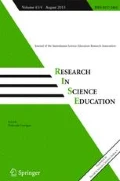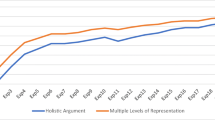Abstract
This study aimed to examine the written arguments developed by college freshman students using the Science Writing Heuristic approach in inquiry-based general chemistry laboratory classrooms and its relationships with students’ achievement in chemistry courses. Fourteen freshman students participated in the first year of the study while 19 freshman students participated in the second year of the study. Two frameworks, an analytical and a holistic argument framework, were developed to evaluate the written argument generated by students. The analytical framework scored each argument component separately and allocated a Total Argument score while the holistic framework evaluated the arguments holistically. Three hundred and sixty-eight samples from 33 students were evaluated. Stepwise regression analyses revealed that the evidence and the claims–evidence relationship components were identified as the most important predictors of the Total Argument and the Holistic Argument scores. Students’ argument scores were positively correlated with their achievement, as measured by the final grade received for the general chemistry laboratory and the general chemistry lecture course.
Similar content being viewed by others
References
Bazerman, C. (1988). Shaping written knowledge: the genre and activity of the experimental article in science. Madison: University of Wisconsin Press.
Bell, P., & Linn, M. C. (2000). Scientific arguments as learning artifacts: designing for learning from the web with KIE. International Journal of Science Education, 22, 797–817.
Blair, J. A., & Johnson, R. H. (1987). Argumentation as dialectical. Argumentation, 1, 41–56.
Byrne, M., Johnstone, A. H., & Pope, A. (1994). Reasoning in science: a language problem revealed? Secondary Science Review, 75, 103–107.
Carey, S., & Smith, C. (1993). On understanding the nature of scientific knowledge. Educational Psychologist, 28, 235–251.
Charney, D. (1984). The validity of using holistic scoring to evaluate writing: a critical overview. Research in the Teaching of English, 18(1), 65–81.
Choi, A., Notebaert, A., Diaz, J., & Hand, B. (2010). Examining arguments generated by Year 5, 7, and 10 students in science classrooms. Research in Science Education, 40(2), 149–169.
Clark, D. B., & Sampson, V. (2008). Assessing dialogic argumentation in online environments to relate structure, grounds, and conceptual quality. Journal of Research in Science Teaching, 45, 293–321.
Cohen, J., Cohen, P., West, S. G., & Aiken, L. S. (2003). Applied multiple regression/correlation analysis for behavior sciences (3rd ed.). Mahwah: Erlbaum.
Connally, P. (1989). Writing and the ecology of learning. In P. Connally & T. Vilardi (Eds.), Writing to learn mathematics and science (pp. 1–14). New York: Teachers College Press.
Cooper, C. (1977). Holistic evaluation of writing. In C. Cooper & L. Odell (Eds.), Evaluating writing: describing, measuring, judging. Urbana: National Council of Teachers of English.
Dolan, E., & Grady, J. (2010). Recognizing students’ scientific reasoning: a tool for categorizing complexity of reasoning during teaching by inquiry. Journal of Science Teacher Education, 21, 31–55.
Driver, R., Asoko, H., Leach, J., Mortimer, E., & Scott, P. (1994). Constructing scientific knowledge in the classroom. Educational Researcher, 23, 5–12.
Driver, R., Leach, J., Millar, R., & Scott, P. (1996). Young people’s images of science. Philadelphia: Open University Press.
Driver, R., Newton, P., & Osborne, J. (2000). Establishing the norms of scientific argumentation in classrooms. Science Education, 84, 287–312.
Erduran, S., Simon, S., & Osborne, J. (2004). TAPping into argumentation: developments in the application of Toulmin’s argument pattern for studying science discourse. Science Education, 88(6), 915–933.
Ford, M. (2008a). ‘Grasp of Practice’ as a reasoning resource for inquiry and nature of science understanding. Science Education, 17, 147–177.
Ford, M. (2008b). Disciplinary authority and accountability in scientific practice and learning. Science Education, 92(3), 404–423.
Ford, M., & Forman, E. (2006). Redefining disciplinary learning in classroom context. Review of Research in Education, 30(1), 1–32.
Gilbert, J. (2005). Visualization: a metacognitive skill in science and science education. In J. Gilbert (Ed.), Visualization in science education. Dordrecht: Springer.
Halliday, M. A. K., & Martin, J. R. (1993). Writing science: literacy and discursive power. Pittsburgh, PA: University of Pittsburgh Press.
Hand, B. (Ed.). (2008). Science inquiry, argument and language. Rotterdam: Sense.
Hays, W. L. (1994). Statistics (5th ed.). Fort Worth: Harcourt Brace.
Holliday, W. G., Yore, L. D., & Alvermann, D. E. (1994). The reading–science learning–writing connection: breakthroughs, barriers, and promises. Journal of Research in Science Teaching, 31, 877–893.
Huot, B. (1990). Reliability, validity, and holistic scoring: what we know and what we need to know. College Composition and Communication, 41(2), 201–213.
Jimenez-Aleixandre, M. P., Bugallo-Rodriguez, A., & Duschl, R. A. (2000). “Doing the lesson” or “doing science”: argument in high school genetics. Science Education, 84, 757–792.
Kelly, G. J., & Bazerman, C. (2003). How students argue scientific claims: a rhetorical–semantic analysis. Applied Linguistics, 24(1), 28–55.
Kelly, G. J., & Chen, C. (1999). The sound of music: constructing science as sociocultural practices through oral and written discourse. Journal of Research in Science Teaching, 36(8), 883–915.
Kelly, G. J., & Takao, A. (2002). Epistemic levels in argument: an analysis of university oceanography students’ use of evidence in writing. Science Education, 86, 314–342.
Kelly, G. J., Drucker, S., & Chen, K. (1998). Students’ reasoning about electricity: combining performance assessment with argumentation analysis. International Journal of Science Education, 20, 849–871.
Kelly, G. J., Regev, J. Prothero, W. (2005). Assessing lines of evidence with argumentation analysis. Paper presented at the annual meeting of the National Association for Research in Science Teaching, Dallas TX, April 4–7.
Keys, C. W. (1999). Revitalizing instruction in scientific genres: connecting knowledge production with writing to learn in science. Science Education, 83, 115–130.
Keys, C. W., Hand, B., Prain, V., & Collins, S. (1999). Using the Science Writing Heuristic as a tool for learning from laboratory investigations in secondary science. Journal of Research in Science Teaching, 36(10), 1065–1084.
Klein, J., & Taub, D. (2005). The effect of variations in handwriting and print on evaluation of student essays. Assessing Writing, 10, 134–148.
Knaggs, C., & Schneider, R. (2012). Thinking like a scientist: using vee-maps to understand process and concepts in science. Research in Science Education, 42, 609–632.
Kozma, R., & Russell, J. (2007). Students becoming chemists: developing representational competence. In J. Gilbert (Ed.), Visualization in science education. Dordrecht: Springer.
Kozma, R., Chin, E., Russell, J., & Marx, N. (2000). The role of representations and tools in the chemistry laboratory and their implications for chemistry learning. The Journal of the Learning Sciences, 9(2), 105–143.
Kuhn, D. (1991). The skills of argument. Cambridge: Cambridge University Press.
Kuhn, D. (1993). Science as argument: implications for teaching and learning scientific thinking. Science Education, 77, 319–337.
Lemke, J. L. (1998). Multiplying meaning: visual and verbal semiotics in scientific text. In J. R. Martin & R. Veel (Eds.), Reading science. London: Routledge.
McCrindle, A. R., & Christensen, C. A. (1995). The impact of learning journal on metacognitive and cognitive processes and learning performance. Learning and Instruction, 5, 167–185.
Moore, R. (1993). Does writing about science improve learning about science? Journal of College Science Teaching, 22, 212–217.
Moskal, B. M. (2000). Scoring rubrics: what, when and how? Practical Assessment, Research & Evaluation, 7(3). Retrieved Dec 20, 2009 from http:PAREonline.net.
National Research Council (NRC). (1996). National science education standards. Washington, D.C.: National Academy Press.
National Research Council (NRC). (2000). Inquiry and the national science education standards. Washington, D.C.: National Academy Press.
National Research Council (NRC). (2012). A framework for K-12 science education: practices, crosscutting concepts, and core ideas. Washington, D.C.: National Academy Press.
Newton, P., Driver, R., & Osborne, J. (1999). The place of argumentation in the pedagogy of school science. International Journal of Science Education, 21(5), 553–576.
Osborne, J. (2002). Science without literacy: a ship without a sail? Cambridge Journal of Education, 32(2), 203–218.
Osborne, R., & Freyberg, P. (Eds.). (1985). Learning in science: the implications of children’s science. London: Heinemann.
Osborne, J., Erduran, S., & Simon, S. (2004). Enhancing the quality of argumentation in school science. Journal of Research in Science Teaching, 41(10), 994–1020.
Patterson, E. W. (2001). Structuring the composition process in scientific writing. International Journal of Science Education, 23, 1–16.
Rivard, L. P. (1994). A review of writing to learn in science: implication for practice and research. Journal of Research in Science Teaching, 31, 969–983.
Russell, M., & Tao, W. (2004). Effects of handwriting and computer-print on composition scores: a follow-up to Powers, Fowles, Farnum, & Ramsey. Practical Assessment, Research & Evaluation, 9(1).
Sampson, V., & Clark, D. (2008). Assessment of the ways students generate arguments in science education: current perspectives and recommendations for future directions. Science Education, 92, 447–472.
Sampson, V., & Clark, D. (2009). The impact of collaboration on the outcomes of scientific argumentation. Science Education, 93, 448–484.
Sandoval, W. A., & Millwood, K. A. (2005). The quality of students’ use of evidence in written scientific explanation. Cognition and Instruction, 23(1), 23–55.
Scott, P. H., Asoko, H., & Leach, J. (2007). Student conceptions and conceptual learning in science. In S. K. Abell & N. Lederman (Eds.), Handbook of research in science education (pp. 31–56). Mahwah: Erlbaum.
Shrout, P. E., & Fleiss, J. L. (1979). Intraclass correlations: use in assessing rater reliability. Psychological Bulletin, 86(2), 420–428.
Simon, S., Erduran, S., & Osborne, J. (2006). Learning to teach argumentation: research and development in the science classroom. International Journal of Science Education, 28(2–3), 235–260.
Takao, A. Y., & Kelly, G. J. (2003). Assessment of evidence in university students’ scientific writing. Science Education, 12, 341–363.
Taylor, C. (1996). Defining science. Madison: University of Wisconsin Press.
Toulmin, S. (1958). The uses of argument. Cambridge: Cambridge University Press.
Vygotshy, L. S. (1962). Thought and language. Cambridge: MIT Press.
Wray, D., & Lewis, M. (1997). Extending literacy: children reading and writing non-fiction. London: Routledge.
Author information
Authors and Affiliations
Corresponding author
Rights and permissions
About this article
Cite this article
Choi, A., Hand, B. & Greenbowe, T. Students’ Written Arguments in General Chemistry Laboratory Investigations. Res Sci Educ 43, 1763–1783 (2013). https://doi.org/10.1007/s11165-012-9330-1
Published:
Issue Date:
DOI: https://doi.org/10.1007/s11165-012-9330-1




